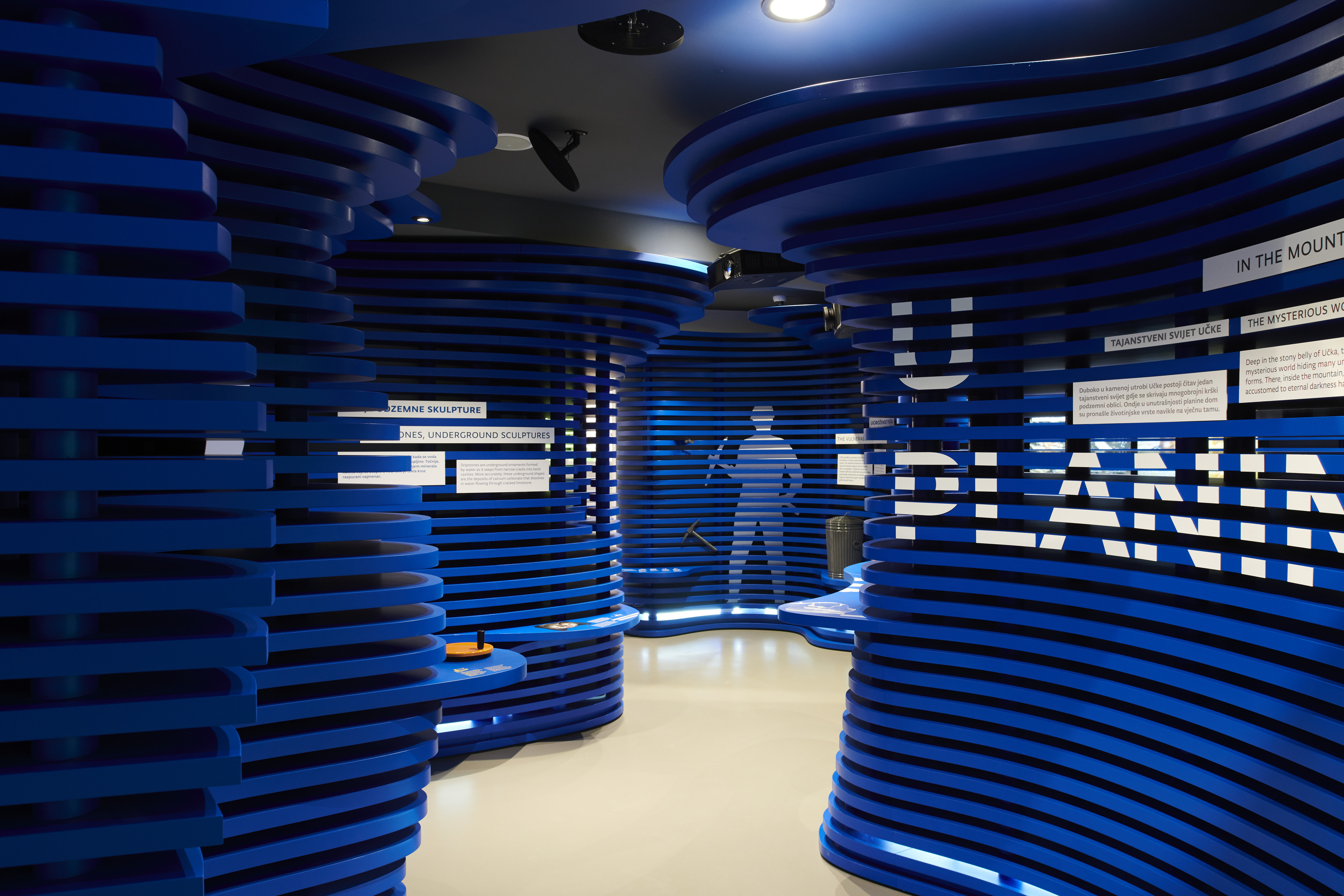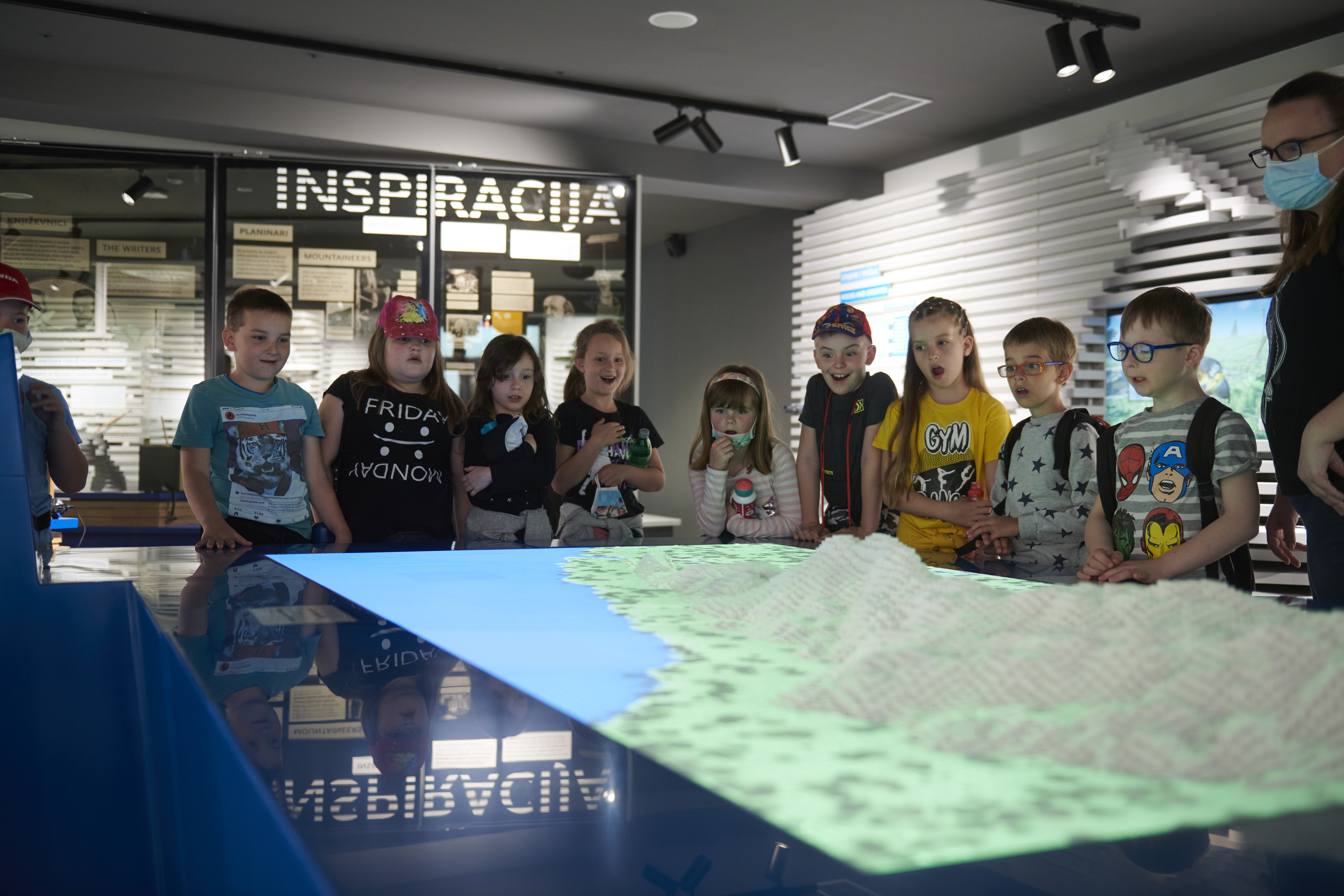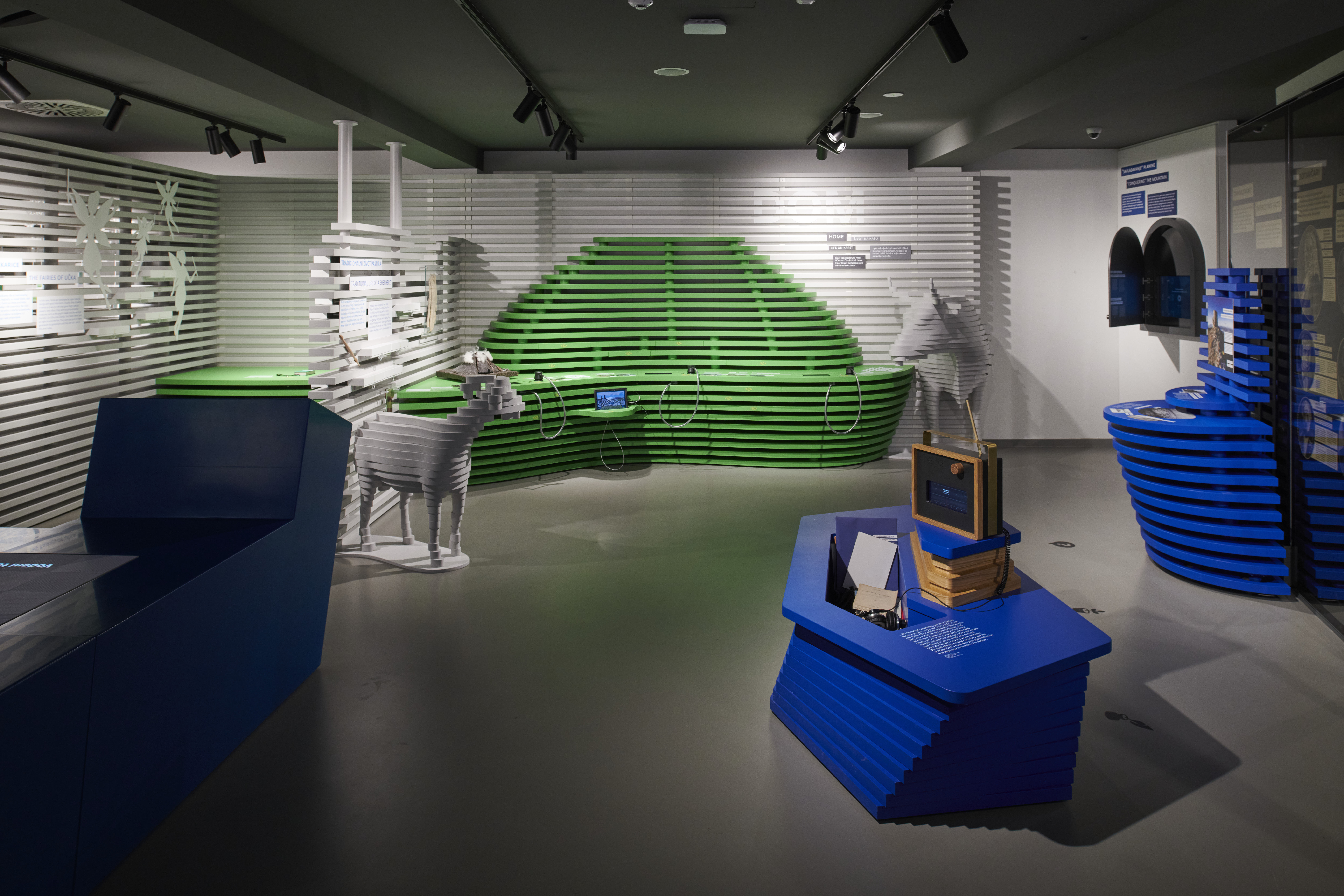The permanent exhibition of the Poklon Visitor Centre, located in the heart of the Učka Nature Park in Croatia, overwhelms and enchants visitors. Interpretation of a vast locality rich with natural and cultural values educates and raises awareness for sustainability. It introduces the deep heritage tale, celebrating the unshakable link between a man and a mountain while connecting the visitor to the inspiring lessons from the past directly offered by the local community.
The permanent exhibition was a part of a bigger project called Učka 360°, with total value of 6.620.605,93 euro, partly financed by the EU (85% of the acceptable costs) from the European Regional Development Fund.
More information here: https://www.pp-ucka.hr/en/eu-project-ucka-360/
Učka mountain of the Istrian Peninsula is rich in flora and fauna and covers more than 160 km 2 of the nationally protected natural area. Throughout history, Učka Mountain has been a home to many species and communities that shaped the landscape through their harmonious relationship. With the rapid changes in society and settlement of more urban areas, this layered relationship between man and nature is fading away, nature changes its appearance, and many traditional languages, skills, knowledge, and significant intangible heritage are gradually dying out. However, the strong desire of the local community to preserve its own inheritance has catalysed a unique heritage project, the Poklon Visitor Centre’s permanent exhibition was opened.
The Poklon Visitor Centre’s permanent exhibition is an immersive visitor experience created by the intertwined network of interdisciplinary professionals and intensive immersion of the local community. The interactive experience takes the visitor on a historical journey to different natural and cultural treasures, inviting him to explore, learn, and connect.
In addition to raising awareness of the importance of nature protection that surrounds us, the exhibition with great care interprets the intangible heritage.
The creation of this unique in-situ permanent exhibition resulted in the empowerment of the local community, the creation of pride among all stakeholder involved and the transfer of knowledge to younger generations. The cultural identity that is part of the European mosaic of diversity has been accentuated, while simultaneously contributing to environmental awareness and sustainable ways of tourism.
Please highlight how the project can be exemplary in this context
Učka is a rich natural and cultural location that without further careful management could suffer landscape disturbance and reduction of natural, social, and cultural values. The Poklon Visitor Centre with its permanent exhibition is a primary example of conservation awareness and celebration of multi-layered heritage of the locality. Providing the exhibition space and opening the visitor centre consisted in renovating an existing building, on a frequently visiting place, without intervening with the surrounding environment. The centre is self-sustainable, there is a solar power plant on the roof, LED lighting and heat pumps in every part of the centre. The exhibition cherishes diversity, meets the need to transfer knowledge to newer generations and contributes to the strengthening of a unique identity, therefore improving the life of the local community. Furthermore, the exhibition commits to preserving cultural beliefs, cultural practices, and culture as its own entity while careful structuring of the project, involvement of the local community and a number of interdisciplinary experts as well as incentives for eco-tourism are strong indicators of sustainability.
Please highlight how the project can be exemplary in this context
Naturally, the realisation of the exhibition was not possible without the necessary factors such as sufficient financial resources, coordinated teamwork, the strong desire of the local community to share knowledge, and the willingness of the Park to passionately support every phase of implementation. Systematic research and previously detailed documentation were also essential for the successful realisation of the permanent exhibition. One of the strong guiding thoughts in the development of content for the permanent exhibition was the tendency for more concise, inviting, and bilingual content that can now be successfully experienced by every type of visitor. Renowned and awarded Croatian experts in the field of museology and design are responsible for the creation of the exhibition content, and various scientific experts have been introduced throughout the project phases. It is important to note that the exhibition also has a strong artistic value because collaboration with great local and national photographers, illustrators, modelers, and other audio-visual experts resulted in the creation of more than 1000 multimedia content.
Relevant participants and partners were:
Co-authors of the permanent exhibition:
Dragana Lucija Ratković Aydemir, Muze d.o.o.
Vedran Kasap, Clinica studio d.o.o.
Marko Šesnić, Šesnić&Turković d.o.o.
Goran Turković, Šesnić&Turković d.o.o.
Vladimir Končar, Revolucija dizajna d.o.o.
Igor Pauška, Kultura d.o.o.
Production of the permanent exhibition:
Muze d.o.o., Heritage Interpretation and Content Development
Šesnić&Turković d.o.o., Graphic Design
Clinica studio d.o.o., Product Design
Kultura d.o.o., Lighting Design
Novena d.o.o., Multimedia Applications
AVC d.o.o., Multimedia System, Multimedia Equipment
Pijole-G d.o.o., Lighting
Internova d.o.o., Product Design
Ars kopija d.o.o., Printing
And more than 100 members of the local community, NGO-s and cultural institutions.
Please highlight how the project can be exemplary in this context
For this project, the local community serves as a starting point, a continual reference, a key stakeholder who is consistently present throughout the project, and an important heir of pride for interpreting natural and cultural assets. Because the younger generations are the future bearers of the community's identity, knowledge exchange is critical to the exhibition experience. The exhibition serves as a potent stimulant for the education of children and youth of various ages. In order to promote equality and the celebration of one's own ideals, the exhibition content was developed with a wide variety of visitors in mind, regardless of their age, gender, origin, or limitation.
An important part of the exhibition experience is participatory learning and creating a personal connection with the presented content so that every visitor can create a long-lasting memory and a deeper, more meaningful and mindful relationship with the interpreted heritage.
Visitors are extremely pleased with the exhibition content which can be deduced from feedback in the form of interviews with employees, comments in the electronic Book of Impressions posted in the lobby of the exhibition, and online reviews on Google Business platform that reach more than 18.402 views. In the reviews, users mostly emphasize interactivity, multimedia experience and interesting and revealing content.
From the opening of the Poklon Visitor Centre (and its exhibition) on May 25, 2021, until the end of last year, we measured the following audience:
- More than 100.000 visitors in the Učka Nature Park
- More than 35.000 visitors to the Poklon Visitor Centre
- 37.730 views of the new Učka Nature Park’s web page
- 18.086 followers on Učka Nature Park’s social media (Facebook and Instagram)
Please highlight how this approach can be exemplary
All three dimensions of the New European Bauhaus, enriching, sustainable, inclusive, have been met through the project results. The realisation of the permanent exhibition was conceived as a multi-phase and long-term process in which the museological concept, ways of interpreting natural and cultural heritage, cost estimate with all exhibition elements, and technical specifications of the permanent exhibition were gradually upgraded.
The Poklon Visitor Centre’s permanent exhibitions is a result of a passionate collaboration with the local community, a harmonious interdisciplinary team, and a number of creatives that contributed to the realisation of a unique in-situ place that celebrates the unbreakable bond of man and nature. The exhibition greatly contributes to climate action & sustainability promoting eco-tourism and the importance of landscape preservation, while raising awareness of our role in impacting the nature that surrounds us. The exhibition space is rich with digital solutions that highlight interactivity and participation, creating an inviting and immersive experience. The local community is the heart of the project while the interpretation of its rich cultural values creates a great feeling of pride and strengthens a unique sense of place and identity that is a valuable part of the European heritage mosaic.
All of the project goals are aimed toward the contribution to the preservation and enhancement of the historical, cultural, environmental, educational, and social value of the natural and cultural heritage. Since the heart of the project is the local community and its interchangeable relationship with nature, Poklon Visitor Centre’s (and the permanent exhibition's) goals contribute to the necessity of sustainable heritage management and a deeper understanding of our own identity. Goals that contribute to a sustainable form of tourism have been achieved with the establishment of the Poklon Visitor Centre and the chance of seeing the permanent display. Visitors are more interested in visiting the Park outside of the summer months because of the additional interpretative material, resulting in an increase in active leisure and a responsible stay in nature, as well as a reduction in seasonality.
The exhibition promotes specific natural and cultural-historical sites to encourage visitors to explore the Park even more, extend their stay, and return.
The exhibition's interpretation of local eco-products is a valuable component that has resulted in an increase in interest in local manufacturing, which has resulted in increased revenue for the local community. Finally, the opening of the permanent exhibition of the visitor centre contributed to the stronger operation of the Učka Nature Park, the inspiration of each visitor, and the improvement of the quality of life of each member of the local community.
Please also explain the benefits that derived from their involvement.
Poklon Visitor Centre’s permanent exhibition arose from the need of the local community to preserve its own heritage. Heritage and scientific associations have thus been a source of stories and materials and an indispensable part of the process.
Due to the involvement of civil societies and the use of interactive media, the visitor can get to know the last charcoal burners from Ćićarija, the traditional cattle breeders and drystone wall masters, many myths and legends, traditional cuisine and music, and the recordings of original speakers of the Vlaški and Žejanski language, spoken by less than 500 speakers in the Učka area. In addition to cultural heritage, a strong collaborator in the field of natural heritage was the association BIOM, which supported the exhibition with valuable material and knowledge of the site as well as content verification throughout the whole process. The benefit of such participatory work is an exceptional sense of pride in the project by the local community, preservation of the endangered heritage and the possibility of passing on valuable knowledge to future generations. The sense of presence and energy of the place that can be felt by the visitor also allows for the creation of intercultural dialogue which extends beyond local borders.
The catalyst for systemised nature protection was created in 2011 when the Ministry of Environmental Protection and Nature of the Republic of Croatia started the project initiative to integrate the Croatian Ecological Network into the largest coordinated network of protected areas in the world, European Ecological Network Natura 2000. The main goal of the project was to strategically improve the natural protection system of every protected area in the country. The realisation of the Poklon Visitor Centre’s permanent exhibition came from previously implemented project activities. The project was designed to meet the conditions for economic sustainability, and thorough research and segmentation of visitor groups has contributed to creating clear images of the user, his interests, needs, and habits.
Conservation of biodiversity is extremely important for the preservation of life on earth and for maintaining a balanced relationship between different bio-systems. Poklon Visitor Centre’s permanent exhibition, through education and interpretation, raises awareness of climate change to protect life on the land and reduce the negative impact on the environment.
It is important to note that the exhibition content is designed to encourage the participation of visitors and further calls to action so that they return to their local community with a higher level of understanding and a positive impact on society.
Poklon Visitor Centre's permanent exhibition is the only space in-situ that interprets cultural and natural heritage in a systematic way. With more than 1000 visual materials, the exhibition became a relevant archive of the site, and a unique medium for the preservation of natural heritage and awareness of the man impact in nature. Social innovation is visible in the involvement of the local community through all phases of implementation, while heritage interpretation transfers heritage values in an unforgettable visitor experience.
Several interdisciplinary experts (museologists, ethnologists, product, graphic and IT designers, biologists etc.) participated in all phases of the implementation and can further apply the carefully designed methodology to other heritage projects. Each element of the exhibition is tailored specifically for the space. Through the exhibition, the visitor can experience unique digital solutions: perceive the echolocation of bats, build their dry-stone wall, move, and learn about the mountain through a kinetic model or stand on the mountain peak with an interactive 360°display.
Please provide clear documentation, communication of methodology and principles in this context.
The initial stage (in 2017) was to arrange workshops with members of the local community and Park officials to highlight heritage opportunities and obtain verified data. We defined the Centre's main principles and goals, as well as the interpretive strategy and conceptual design of the show, based on the workshop outcomes.The paperwork that specified the exhibition's synopses, the theme units that delivered the interpretative messages, and the detailed elaboration of visual and textual materials and mediums came after that.The final part of the project, the installation of the Poklon Visitor Centre's permanent exhibition, began in 2019.
At each stage of the permanent exhibition development, we were guided by extensive research and participatory work. For each phase of the project, the coherence and relevance of all presented information were critical. Every step of the implementation was dominated by scientific verification, therefore we worked closely with experts in biology, geology, hydrogeology, and cultural heritage with the local community, language advisers, local cultural institutions, and heritage associations. The significant archival material that was shown in partnership with amenable individuals, authorities, and institutions is a strong feature of the presentation. The whole process is carefully documented to be used for future reference and research.
Exhibition space video: https://www.youtube.com/watch?v=FJPENtNwnNU






@Muze d.o.o. / Muses Ltd on behalf of the Učka Nature Park, owner of the Poklon Visitor Centre’s permanent exhibition, 2021
Content licensed to the European Union.